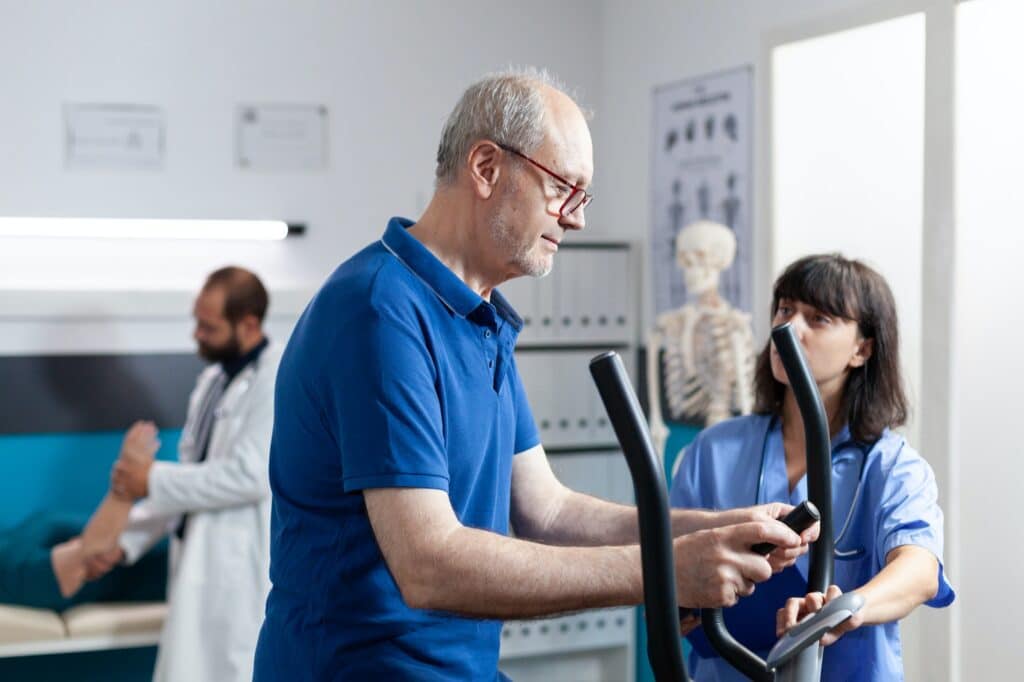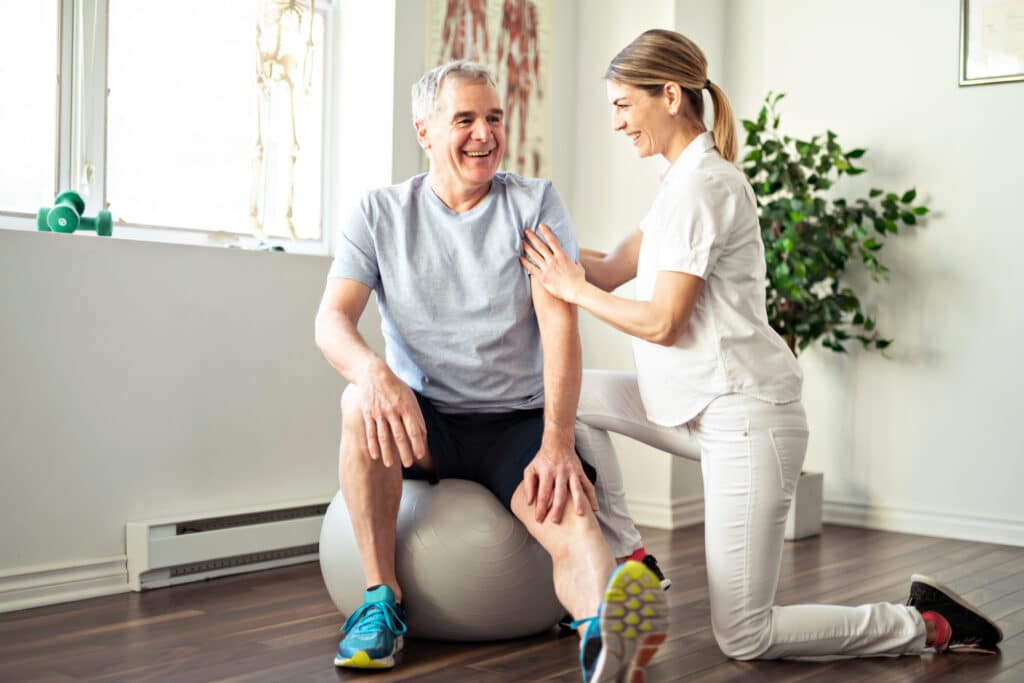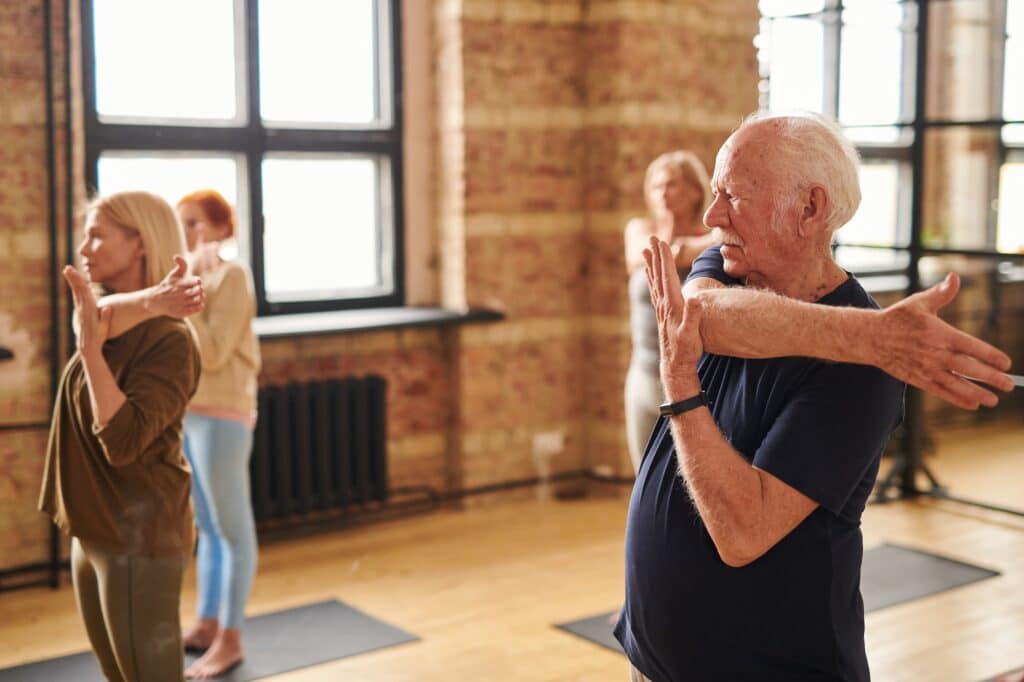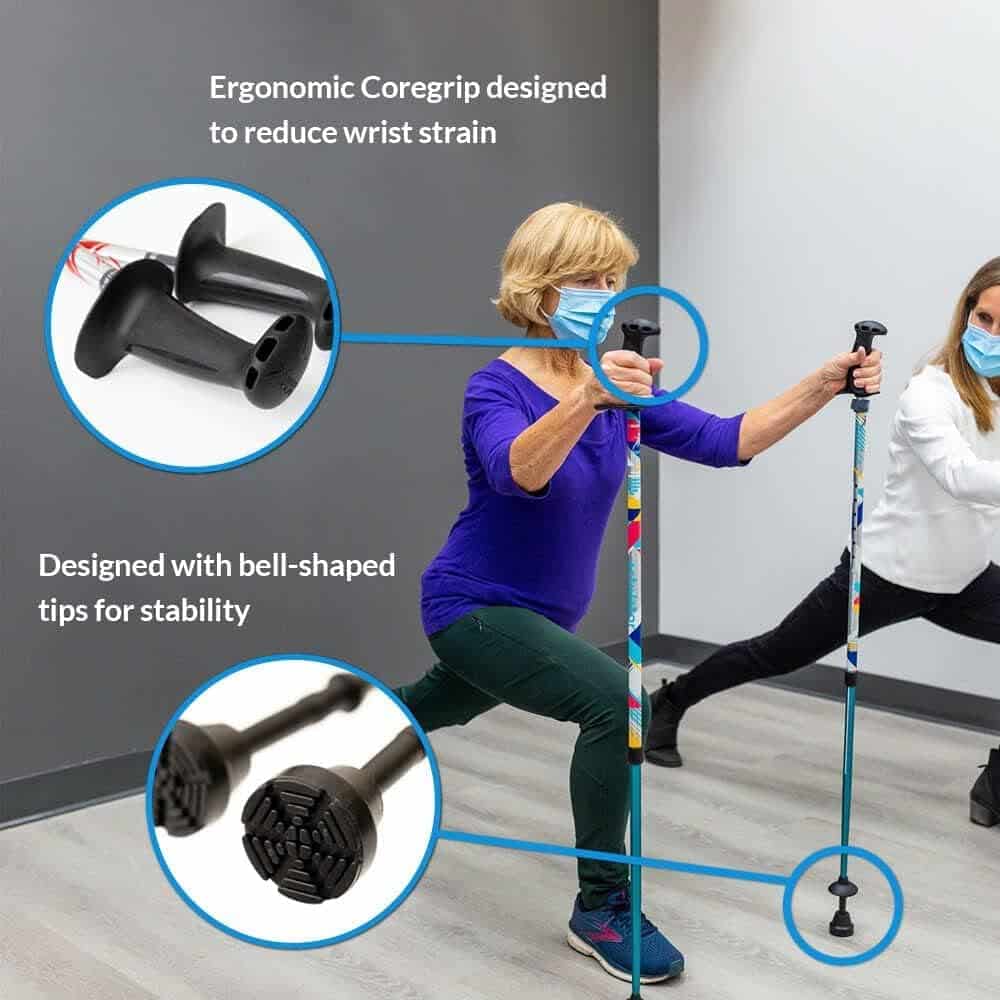If you’ve been diagnosed with Parkinson’s disease, you are not alone. According to the Parkinson’s Foundation, nearly one million people in the United States are affected by this condition, and that number is expected to rise.
One of the most effective ways to manage symptoms and improve quality of life is through Parkinson’s exercise programs. These programs are designed to maintain brain function, improve motor skills, and enhance overall well-being.
In this article, we explore the importance of exercise for Parkinson’s patients and highlight various exercise programs tailored to combat the progression of the disease.
Discover how strength training, balance exercises, aerobic workouts, and specialized programs like LSVT-BIG and LOUD can significantly improve your Parkinson’s journey.
Whether you’re seeking stability through walking poles, exploring group classes, or engaging in sports, the right exercise regimen can help you reclaim control and improve your daily life.
The Importance of Exercise for Parkinson’s Disease
Parkinson’s Disease can have a wide range of effects on your well-being, including tremors, rigidity, difficulty walking or initiating movement, displaying smaller-than-usual movements, and speaking unusually softly.
Exercise is considered neuroprotective since it helps the brain maintain and build new pathways and increases the utilization of dopamine, the central brain chemical involved in PD.
In some cases, neuroplasticity, or brain adaptation from exercise, can even outpace the effects of neurodegeneration from Parkinson’s Disease.1
Exercise during early disease onset also contributes to a slower decline in function and improved quality of life compared to that of inactive patients or those who started exercising later in the disease process.1
Let’s examine some specific Parkinson’s disease exercise programs and how they might be useful as you navigate the terrain of Parkinson’s.
Types of Exercise for Parkinson’s Disease

While there is no single best method recommended for all patients, consistent exercise has been proven to slow the progression of Parkinson’s, reducing the overall impact of the disease.
Parkinson’s is generally associated with smaller, slower movements that diminish over time without intervention. For this reason, exercises for Parkinson’s Disease usually emphasize large amplitude body movements to restore or maintain normal motor patterns.
Here are some general categories you might explore with your physical therapist:
Strength training exercises
Strength exercises may include bodyweight resistance exercises, resistance band workouts, or weight training. The goal of strength training is to build muscle mass and function, which can help reduce the slowing of movement, known as bradykinesia.
A strength training exercise program might include specific skills such as squatting to get up and down from a seated position or other functional exercises.
Balance exercises and stretching
Balance exercises are useful for teaching you how to move safely to reduce your risk of falling, especially as Parkinson’s progresses. Regular stretching can help maintain flexibility and reduce stiffness.
In addition to the exercise regimen prescribed by your PT, balance and stretching-based exercises are commonly found in classes like yoga or Tai Chi.
Aerobic exercise
Aerobic exercise promotes cardiovascular health and endurance, improving the body’s ability to utilize oxygen efficiently through activities like swimming, walking, or biking.
Studies show that aerobic exercise can lead to increased blood flow to motor regions of the brain to improve movement function.2
Using Poles for Stability During Exercise
Many of our Parkinson’s patients like to use walking poles for added security during exercise. The type of poles you use definitely makes a difference. Urban Poling ACTIVATOR Poles are our #1 recommendation. Urban Poling ACTIVATOR Poles were designed by an occupational therapist & gerontologist specifically for rehab and long-term conditions. The smart design enhances strengthening, stability and off-loading with your safety in mind. These are the right support tool while challenging yourself through a Parkinson’s exercise program.
Our recommendations are the same items we trust and prescribe to patients. When you buy through links like this on our site, we may earn an affiliate commission to support new content.
Cognitive & Skill-Based Exercise prescription
Cognitive skill-training challenges like playing memory recall or pattern recognition games –especially during exercise – require increased mental focus and brain stimulation typically associated with learning a new skill.2
Skill-based exercises are goal-oriented and accuracy-based, like learning a new sport or trying to remember a dance sequence. Based on animal studies, skill-based exercise can increase the number of synapses per neuron, leading to greater neuroplasticity.2
Research by The Parkinson’s Outcomes Project found that a minimum of two and a half hours of exercise, spread across your week, is optimal for improvement.
As you can see, a combination of strategies based on your needs and abilities creates the most effective path to minimizing the effects of Parkinson’s Disease.
Parkinson’s Disease-Specific Exercise Programs

Specific exercise programs can significantly improve mobility, strength, and overall quality of life when it comes to managing Parkinson’s disease.
These specialized programs are designed to address the unique challenges faced by those with Parkinson’s, offering tailored exercises and therapies that promote neuroplasticity and functional improvement.
Below are some of the most effective Parkinson’s Disease-specific exercise programs available.
LSVT-BIG & LOUD Therapeutic Exercise
LSVT-BIG (The Lee Silverman Voice Treatment) is a specialized, physical therapist-guided program that uses large amplitude body movements to improve speed and reduce hesitation.3
LSVT-BIG is individualized to help patients recalibrate their movement patterns to restore the “normal” amplitude of movement. It promotes neuroplasticity to minimize degeneration and explores and acknowledges emotional and cognitive changes.
LSVT-BIG has been shown to improve motor performance and overall quality of life in patients after only four weeks of training, with more significant improvements across longer treatment periods.3,4
LSVT-LOUD is an associated program administered by a certified speech therapist focusing on normalizing speech.
Similarly to BIG’s emphasis on movement, LOUD encourages patients to speak up again by “recalibrating” their perception and countering a minimized speaking voice.5
LSVT-LOUD focuses on frequent, high-intensity treatments. Research shows not only improvements in loudness of voice but also overall improved communication ability and articulation of words.5
Other Group Exercise Classes for Parkinson’s Disease
Fortunately, there is also a wide range of Parkinson’s-specific group exercise classes that utilize several of these components both online and in-person around the United States.
Parkinson’s Wellness Recovery (AKA PWR!) is led by certified physical therapists or other fitness professionals. PWR! focuses on four main movements that mimic necessary skills, which can be practiced in varied positions and progressed both physically and cognitively for greater challenges.6
Currently, PWR gyms are mostly located in Arizona, but online classes, instructors, and resources can also be found online here at Physio Ed.6
The Southern California-based Parkinson’s Exercise Program 4 You (PEP4U) offers free exercise programs focusing on balance, coordination, and strength. They also provide online classes to those outside of California.7
OhioHealth offers Delay the Disease, a symptom-specific training for the mind and body, which can also be accessed online.8
Finally, check with your local YMCA or community center for Parkinson’s-specific classes near you, and be sure to ask the members of your healthcare team about other local resources.
If you’re eager to get moving but wary of in-person classes, the American Parkinson’s Disease Association has links to many free online resources to help you get started.12
Remember to visit Physio Ed.’s YouTube channel for free classes ranging from yoga to pilates to neuro boxing and dance classes, with step-by-step instructions clinically tailored to older people.
Sports for Parkinson’s Disease
Participating in a sport is another great way to stay active and healthy. Many sports are skill-based (requiring increased brain power) and aerobic in nature, which can benefit those living with Parkinson’s Disease by boosting weekly exercise time.
Boxing is rigorous and requires large movement patterns, rhythm/skill, strength, and balance, making it a popular choice for Parkinson’s patients.
Rock Steady Boxing offers Parkinson’s boxing classes around the world, led by skilled, trained coaches.9
Golf is another safe and popular option for people with Parkinson’s disease. One study even found that golf produced greater improvement in walking test results for some participants than for others who participated in Tai Chi, which has also been established as highly beneficial for people with Parkinson’s disease.10
Research continues for various activities, including martial arts like karate and qigong. While initial results appear to show positive effects for people with Parkinson’s, it is clear that physical activity and exercise, regardless of the variety, are highly beneficial in combatting Parkinson’s disease, especially in its earlier stages.11
Starting an exercise program during the early stages of Parkinson’s is one of the best things you can do to boost your balance skills and combat movement challenges that many people with Parkinson’s disease experience.
Specific exercises focusing on big movements and motor function combined with aerobic activity and muscle strength can not only help with disease management but can also improve memory and longevity.
Different exercises will be prescribed for different patients, but staying active with a carefully selected exercise routine can be your first defense against the later stages of Parkinson’s Disease.
Key Takeaways
- Parkinson’s disease affects roughly one million people in the United States, with numbers expected to rise in the coming years.
- Exercise is crucial for Parkinson’s patients as it is neuroprotective, aiding in maintaining and building new brain pathways and increasing dopamine utilization.
- Consistent exercise can slow the progression of Parkinson’s disease, improve quality of life, and enhance motor function.
- Strength training, balance exercises, stretching, and aerobic exercise are vital components of a Parkinson’s disease exercise program.
- Using walking poles can provide added stability during exercise for Parkinson’s patients.
- Cognitive and skill-based exercises, such as memory recall or learning new sports, can enhance neuroplasticity and improve motor skills.
- Specialized exercise programs like LSVT-BIG and LOUD, designed for Parkinson’s patients, focus on large-amplitude body movements and normalizing speech volume.
- Group exercise classes and sports such as boxing and golf can benefit Parkinson’s patients by boosting physical activity and improving motor function.
- Early intervention with exercise can significantly combat movement challenges and boost balance skills in Parkinson’s patients.
- A combination of exercise types tailored to individual needs can be the most effective strategy in managing Parkinson’s disease and improving overall well-being.
FAQs
What is Parkinson’s disease and how common is it?
Parkinson’s disease is a neurodegenerative disorder that affects movement and can cause tremors, rigidity, and difficulty with walking and speech. It affects nearly one million people in the United States, and this number is expected to rise significantly in the coming years.
Why is exercise important for Parkinson’s patients?
Exercise is crucial for Parkinson’s patients because it is neuroprotective, helping to maintain and build new brain pathways and increase dopamine utilization. Consistent exercise can slow the progression of the disease, improve motor function, and enhance overall quality of life.
What types of exercises are beneficial for Parkinson’s disease?
Beneficial exercises for Parkinson’s disease include strength training, balance exercises, stretching, and aerobic activities. These exercises help improve muscle mass, flexibility, cardiovascular health, and overall motor function.
How does the LSVT-BIG & LOUD program help Parkinson’s patients?
The LSVT-BIG program focuses on large-amplitude body movements to improve speed and reduce hesitation in movement, while the LSVT-LOUD program aims to normalize speech volume. Both programs promote neuroplasticity and have been shown to improve motor performance and communication abilities in Parkinson’s patients.
Can group exercise classes be beneficial for Parkinson’s patients?
Yes, group exercise classes can be highly beneficial for Parkinson’s patients. Programs like Parkinson’s Wellness Recovery (PWR!), Parkinson’s Exercise Program 4 You (PEP4U), and OhioHealth’s Delay the Disease offer tailored exercises that improve balance, coordination, and strength. These classes also provide social support and motivation.
What role do cognitive and skill-based exercises play in Parkinson’s treatment?
Cognitive and skill-based exercises enhance neuroplasticity by stimulating the brain and improving motor skills. Activities like memory recall games, learning new sports, or practicing dance sequences require mental focus and can help improve brain function and movement patterns.
Are sports activities recommended for Parkinson’s patients?
Sports activities like boxing and golf are recommended for Parkinson’s patients. These activities are skill-based and aerobic, helping to boost physical activity levels, improve motor function, and enhance overall well-being. Programs like Rock Steady Boxing offer specialized classes for Parkinson’s patients to engage in rigorous exercise safely.









